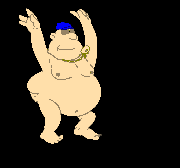
Fatness or Fitness
by Sep Meyer
There is nothing new in any of the information I shall be providing in this article. Nothing new, nothing sensational, nothing that you don't already know.
I simply hope that by writing it in a different style from other articles you will have read, it may make more impact, induce greater resolve, and produce more beneficial results.
Let's start with a few facts and statistics.
Recent studies in the United Kingdom purport to show that obesity has increased tremendously during the past two decades, to the state where the UK now has the highest ratio of obesity to population in Europe; and the group most at risk would appear to be children of school age. Apparently health concerns have taken a minor role compared to watching TV with a junk food meal in ones lap.
The studies indicated a direct correlation between hours of TV watched and a child's body fat. Combining proper exercise with a healthy diet is the key to a healthy lifestyle - for children and for adults. By understanding what exercises burn fat and teaching your child how to exercise safely, you can instill healthy habits that will last a lifetime. But it's important to set an example to your child and to act as a role model.
The situation is paralleled in the United States where obesity is almost reaching the dimensions of an epidemic. One out of three Americans is reported as being overweight. Furthermore, recent studies in the USA have revealed that 90 per cent of Americans do too little exercise to receive any measurable benefit from it. Given the emphasis on sports in that country, it would seem that most people prefer the role of spectator to that of participant.
Now, although appropriate exercise performed regularly will not only improve health and fitness, but will tone muscles (the loss of which is a side effect of dieting, since 25 percent of the weight loss in dieting is muscle tissue), and although the benefits of exercise are well known and widely advertised, overweight people mainly prefer to lose weight by dieting rather than by exercise. The most effective regime for the overweight individual, however, is one that combines dietary care with regular and not too rigorous exercise.

One of the reasons why some people do not persevere with a combined diet and exercise regime, but go instead for a "crash" diet, is that while a diet will produce a relatively quick loss of fat weight, exercise will produce an increase in muscle weight. Of course, the latter is healthy, but it can be quite discouraging to find, at the end of a week's dieting, that you have lost a mere one or two pounds, because you have dropped 6 pounds in fat, but gained 4 pounds in muscle weight. So the apparently easy course is to simply diet and shed those extra pounds quickly. Inevitably, however, any speedy weight loss is as quickly regained.
But whether you diet, or exercise, or diet and exercise, there are options to be considered. Some diets may be more appropriate to your situation than others; some exercises may suit you better and be more beneficial than others.
DIETING
As far as diets are concerned the first cautionary note is: avoid all so-called "wonder" diets. Any drastic change in eating habits is likely to cause an almost immediate loss of weight. But the loss is rarely maintained and the weight is quickly regained, sometimes even exceeding the amount lost. The best diet is the one that can be sustained without leaving the dieter with a feeling of deprivation. And sensible diets - inevitably they are the ones that have stood the test of time - fall into three categories.
[Incidentally, all respectable dietary guides start with the caveat that the prospective dieters are advised to consult their medical practitioner before embarking on a prolonged diet. And this is advice that I certainly echo.]
1. Controlled calorie diets. These are generally regarded as the safest because they do not exaggerate the intake or exclusion of any specific food groups, but work on balanced meals with reduced calories. They are not as "jazzy" as some of the others diets, and dieters may consider them to be rather boring. Nonetheless they work, they do not depend upon deprivation of any essential nutritional elements, and they are not "gimmicky".
2. High protein and low (or no) carbohydrate diets. These can produce startlingly effective results in a very short time and some of them are easily maintained. The first and best-known was probably the Scarsdale diet, subsequently modified and re-presented as the Dr. Atkins Diet. There is a lot to be said for these diets, but there are dangers too. A very considerable intake of water is essential if body nutrients and chemicals are not to be disturbed, as well as to counter some of the unpleasant side effects of this type of diet, such as bad breath. Water (any liquid indeed) is essential regardless of specific dietary benefits, but recent research has revealed that too much liquid intake can also be harmful.
3. High fibre diets. A major benefit of this type of diet is that a lack of fibre in the body has been linked to various diseases such as bowel cancer and varicose veins. The beneficial side-effect is that increasing fibre intake and reducing fats and sugars means that there is a reduction in calorie ingestion which will result in weight loss. Too much fibre, however, can deplete certain of the body's vitamins.

Illustration by Yaron Livay [1]
EXERCISING
Just as a diet, if it is to be successful, has to be sustainable, so exercise that accompanies a diet should not be so onerous or rigorous that overweight individuals find it burdensome or boring.
There are many gentle forms of exercise that may be undertaken by people who lack fitness, that are capable of being maintained at a fairly relaxed level at least until the practitioner's improved energy and reduced weight makes it safe to move to a higher level. And many of them are very enjoyable activities.
The least energetic, and most easily adopted is simply to exercise while sitting down. An example that I read some time ago, and took the precaution of committing to my notebook, proposed "shadow boxing" while seated. It suggested throwing a few punches in the air. "Throw a left, another left and follow with a right, left right. Throw a flurry of mixed punches. Throw some punches to the side. Your head automatically bobs around while throwing the punches, giving your neck a workout as well."

Of course, this is not something you will feel comfortable doing while seated at your office desk in the presence of others. But even there it is possible to practice isometric exercises such as the "chair lift", the "behind neck pull", the "forward lean", the "ankle press", and the "overhead pull". Each of these exercises is performed while seated and involves merely four seconds of increased pressure for each exercise, followed by six seconds of sustained pressure.
isometric exercises are those in which a force is applied to a resistant object. It could be an imaginary object. But to give an example: in the chair lift, the seat of the chair in which you are sitting is held with a hand on either side and you try to lift yourself and the chair off the ground. Pressure is increased for four seconds and then maintained for six seconds. The same technique is used with the other exercises: the behind neck pull has the hands behind the neck with fingers interlaced, head pushing back against hands; the overhead pull has hands joined and interlocked above the head; the forward lean has legs extended and feet about 30 cm above the floor, hands pressing on thighs; the ankle press has legs extended and ankles crossed, the pressure is by each ankle attempting to push the other ankle up, or down as the case may be.[2]
A word of warning. Isometric exercises when performed in a serious manner are really intended for people who are already fit. The exercises mentioned above, when used simply to achieve an increase in physical fitness to accompany a diet, should be performed fairly gently initially. They should not be undertaken strenuously without first getting a professional medical opinion.
Far better for gentle exercising are four other activities.
1. Dancing
There are many forms of dancing, ranging from the sedate to the frenetic, and you can have a lot of fun simply trying them all out. Whichever you do, you can be sure that you will be indulging in a keep-fit activity that will help you to burn off the calories, albeit not that many if your taste runs only to the gently elegant. So, be it disco, folk, circle, country, formation or ballroom, do it regularly, enjoy yourself, and trim that fat.

The beauty of dancing is that you don't really need a partner. But music helps.
2. Swimming
The main advantage of swimming as an adjunct to dieting is that it is one of the most effective ways of exercising the muscles, lungs and heart without the strain that is sometimes associated with other forms of exercise. For this reason it is probably the top recommendation of all medical practitioners for their patients of whatever age. And there are few people who do not live within reasonable access of a swimming pool.

3. Cycling
Forget about that stationary piece of equipment that was used with enthusiasm when it was first purchased and now lurks in the corner of the bedroom, or the bathroom, or the garage floor, quietly rusticating if not rusting.

Much better for a whole variety of reasons is a real, live tourer, mountain or sports bicycle that will promote good health, endurance, muscle activity, and coordination. It will also save you money when used as an alternative to a car or public transport, and it is ecologically sound. Get to know your local area, find ways of avoiding roads, and discover local cycle paths and footpaths that permit use by cyclists.
4. Walking

In Michael Mallows' and Joe Sinclair's Peace of Mind is a Piece of Cake [1], they write: ". . . what can you do that's cheap, available and requires little or no preparation? The answer is: walk! Walk your way to fitness! Walk away from stress! All you need is a good pair of shoes.
"This does not mean a five minute stroll to the newsagents. Or ten minutes walking around the aisles of your local supermarket . . . Walking, to do any real good, should be at a pace which will raise the pulse rate, exercise the lungs, and burn off the calories, and this means walking at a speed of at least 5 km per hour. Walk at the right speed, step out energetically, swing your arms, and you will exercise most of the muscles of your body.
"The next time you are about to get into your car, ask yourself 'Can I walk there?' If not, perhaps you can park your car a mile or two from your destination and walk that mile or two. . . Do it often enough and - who knows? - you may end up enjoying it, even looking forward to it, and maybe planning longer walks when you don't have a specific destination."

"All you need is a good pair of boots" - Illustration by Yaron Livay [1]
![]()
SOURCES:
[1] Peace of Mind is a Piece of Cake by Michael Mallows and Joe Sinclair, Crown Publishing, 1998
[2] Isometrics by Henry Wittenberg, Award Books, 1973.
The Complete Book of Good Health, Copp Clark Publishing, 1978.
Rating the Diets by Theodore Berland and the editors of Consumer Guide, Crown Publishers Inc. 1980